For hundreds of years, the Detroit River has been a focus for boating, fishing and hunting, as well as nature viewing and appreciation. New fishing docks and observation platforms have been constructed, and soft-shore engineering projects have enhanced the aesthetics of the river while also improving fish habitat values and access for fishing. Through the DRCC partnership, efforts to restore, enhance and protect fish populations and habitat have improved many fish species’ health and presence in the river overtime. The River is known internationally for its Muskellunge, Walleye, White Bass and Yellow Perch in addition to other sport fisheries.
On this page you can learn about how to fish on the Detroit River! Click the headings in the Table of Contents below to expand the section for more information.
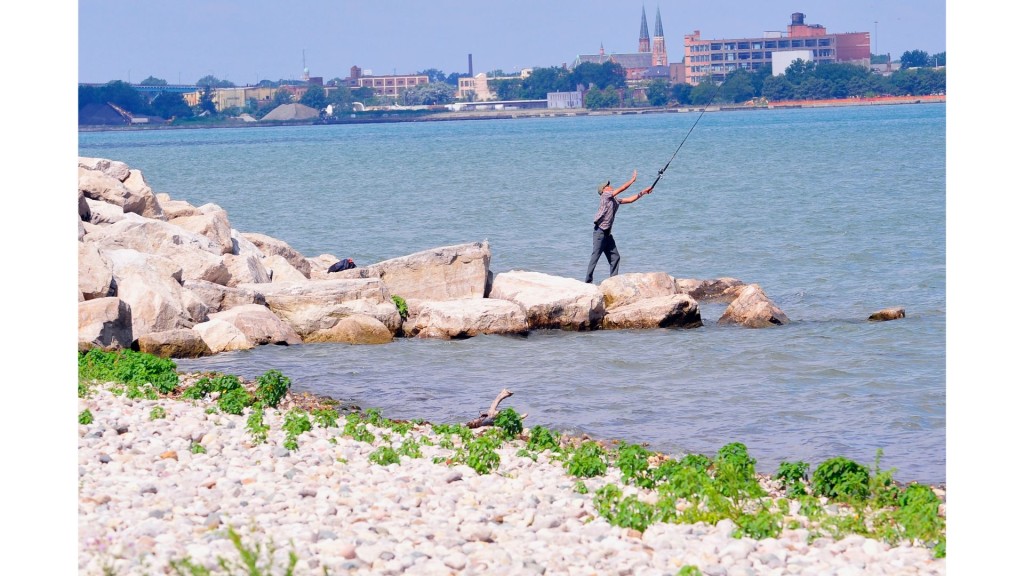
Table of Contents
- Obtaining an Ontario Fishing License
- Fishing Regulations
- License Free Fishing Weekends
- Popular Detroit River Fishing Spots
- Naturalized Shorelines
- Fishing Etiquette and Safety
- Fishing Equipment Essentials
- Fishing Lines
- Choosing Your Bait
- Common Hooks and Harnesses
- Setting up your Fishing Rod
- What can you Expect to Catch
- Handling Detroit River Fish Safely
- Catch and Release
- Catching Species at Risk
- Catching Invasive Species
- How to Measure your Fish
- Eat Safe Fish
- Cleaning Fish from the Detroit River for Consumption
- Recipes
- TWEPI Fishing Guide
- Where to buy Fishing Gear in Windsor-Essex
- Sportsman’s Clubs in the Detroit River Watershed
- Fishing Charters
- Ontario Government Instructional Fishing Videos
1. Obtaining an Ontario Fishing License
Fish and Wildlife Licensing Service: How to use the Ontario Fishing Regulations Summary
Before you start fishing in Ontario, you will need a valid:
- Outdoors Card (a plastic identification card, valid for three calendar years), and
- A fishing license (valid for either one or three calendar years).
A fishing license can be for either conservation (reduced catch limits) or sport (normal catch limits).
While fishing, you must carry your valid Outdoors Card and Licence Summary listing your valid fishing licence, unless your licence is printed on the back of your Outdoors Card.
Only one type of Outdoors Card is now issued for fishing and hunting.
Read more and get your Outdoors card through the Government of Ontario here.
2. Fishing Regulations
Using the Ontario Fishing Regulations Summary
You must follow certain rules while fishing, including catch and possession limits. These rules determine:
- when and where you can fish
- the species, size and number of fish you can keep
- what you can use for bait and tackle
- what you can and cannot do in specific locations (Ontario is divided into 20 Fisheries Management Zones)
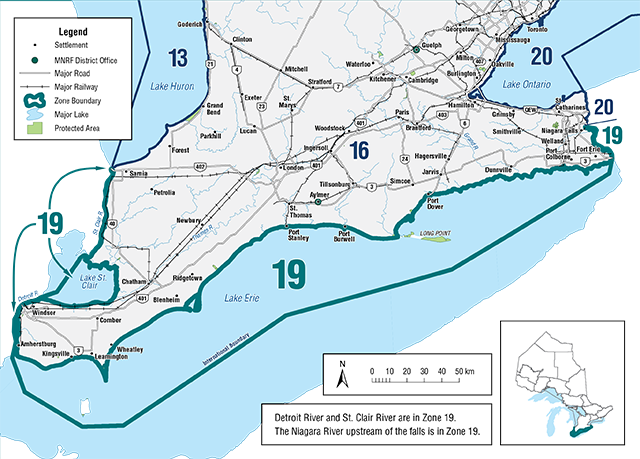
The Detroit River, St. Clair River and Niagara River upstream of Niagara Falls is in Fisheries Management Zone 19. Click here to review more details about Zone 19 and read the zone-wide seasons and limits.
3. License Free Fishing Weekends
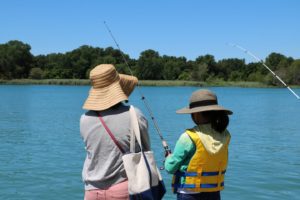
Four times a year, Canadian residents can fish in Ontario without buying a fishing licence, during:
- Family Fishing Weekend in February (February 13-15, 2021)
- Mother’s Day Weekend in May (May 8-9, 2021)
- Father’s Day Weekend in June (June 19-20, 2021)
- Family Fishing Week in July (July 3-11, 2021)
Licence-free periods remind us of the value of Ontario’s recreational fishery, and the importance of keeping it healthy for future generations. You must:
- follow conservation licence catch limits
- obey size limits and sanctuaries
- follow the fishing regulations
4. Popular Detroit River Fishing Spots

There are several popular shoreline fishing spots along the Canadian side of the Detroit River. Click here for a map that highlights these accessible locations.
Learn to Fish Online: Fishing tips
5. Naturalized Shorelines

There are many sections of naturalized shoreline along the Canadian side of the Detroit River, which are also located in common shore fishing spots. While these naturalized shorelines provide ecological benefits such as fish habitat, they can cause snags on fishing line. Vegetation such as shrubs, seedlings and aquatic plants grow in these habitats. It is recommended to scan the area by the water before casting out. When fishing in these areas, using a bobber that will hold your bait above the snag zones will help reduce frustrations of fishing line getting caught. In naturalized areas, any bait that has a heavy sinker or large bills has the potential to become stuck under the rocks and cause you to cut your line and retie a new lure.
To read more about shoreline restoration efforts and explore an interactive story map of projects undertaken by DRCC partners visit our Restore the Shore! page.
6. Fishing Etiquette and Safety
For many anglers, fishing is a time to relax and enjoy being outdoors. Here are some etiquette and safety tips for shore and in river fishing along the Detroit River.

Shoreline Fishing
- Before casting, always look around you to make sure you do not hit a person or object on your backward motion with your fishing rod, line and hook.
- Leave room between you and the angler next to you to show respect for anglers’ fishing spots and personal space.
- Fish spook easily. If you are fishing an area with anglers who are not conversing or being loud, follow suit.
- Always follow fishing regulations when shore or in river fishing.
- Leave your fishing area clean and tidy when done. It is important to not leave hooks, line, fish remains, or any litter when you are done fishing. Help keep the Great Lakes clean and the fish, birds, snakes, turtles and other wildlife safe from tangles or litter.
Boat Safety on the Detroit River
As a steward of the Detroit River, the DRCC knows a healthy river system equals boating, kayaking, jet skiing, canoeing, standup paddle boarding and other forms of shoreline and in river recreation. Who can resist the call of the blue waters? If you are heading out on the water this summer, here are some safety tips to make your boating experience fun and safe this season.
- Wear a life jacket – even if you don’t plan on jumping in, most fatalities with boating are from drowning. Everyone on board including young children should have a life jacket.
- Swimming and boating skills – make sure everyone has taken swimming lessons and is comfortable in the water. This knowledge can be life saving. Never leave children unsupervised on the boat or when in the water.
- Safety equipment – aside from life jackets, pack a fire extinguisher, first-aid kit, flashlight, your cellphone, marine radio and an air horn or whistle for signaling other boats in the river. All of these tools will help in an emergency.
- Plan your route – have your route planned in advance so you can navigate the water carefully and with ease. Better yet, tell someone who isn’t going on your trip where you are going and how long you might be.
- Know your environment – the water in the Detroit River moves fast! The Windsor Port Authority Harbourmaster Peter Berry says some areas of the river are traveling at 20 kilometres an hour. Also, Great Lakes are more likely to have larger waves and be cooler than shallow inland waterways like tributaries. Cold water can lead to hypothermia and unconsciousness in as little as fifteen minutes.
- Watch the weather – wind can rough the water and can pose a hazard to smaller watercraft, especially in the Detroit River. Lightning is also a risk to an open boat exposed on the water. Check the forecast often for any day you plan to be out in the water and delay the trip if weather is hazardous.
- Look before you leap – diving or jumping off a boat can lead to injury if there are underwater items like rocks below.
For more information about safe boating, visit the Government of Canada Getting started with safe boating page here.
7. Fishing Equipment Essentials

There are many retail stores across Windsor-Essex that sell fishing equipment. Here are some essentials below:
- Spinning reel combo (medium action rod and reel)
- Spinning reel
- Medium action fishing rod
- 10 – 12 lb mono fishing line
- Pickerel rigs with hooks and weights
- Long needle nose pliers
- Gloves and towel for handling fish
- Nets or cradle of various sizes
- Live bait (worms or minnows)
- Scissors or nail clippers to snip excess fishing line after knotting
- A tackle box to organize and carry all your gear
- Bobber
If you plan on filleting the fish and eating them:
- A stringer or bucket to put fish in
- A fillet knife to clean the fish
Learn to Fish Online – Fishing Equipment
8. Fishing Lines
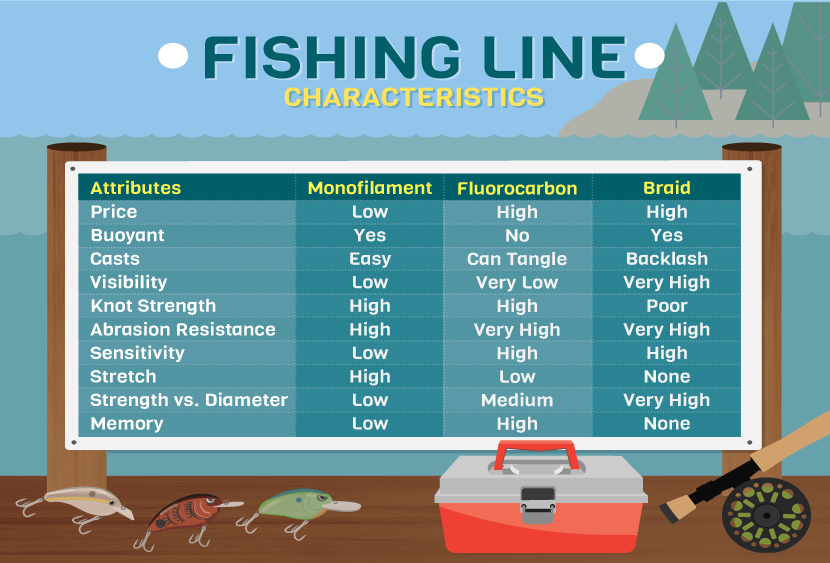
There are three common types of fishing line anglers use on their rods.
Monofilament Line
The most effective line for beginner level fishing is 10-12 lb monofilament, or “mono”, line. This line is durable enough to reel in a big fish, but also thin enough that allows for new anglers to still to tie knots easily. Monofilament is also a low cost line that fits most spinning reels perfectly. An advantage to using monofilament line is that it floats, allowing anglers who use bobbers to see their line when it is being pulled underwater while a fish is hooked.
Fluorocarbon Line
This type of fishing line is a heavier and denser than mono line, making it sink faster to get bait into deeper water fast. This density also makes for a thicker line which can be more difficult for new anglers to mange, commonly causing tangles for less experienced users. When using fluorocarbon line, you cannot use baits that float because it will create slack in the line that fish will be able to see and potentially avoid.
Braided Line
This type of line is used when fishing larger fish that fight hard when hooked. Braided fishing line consists of microlines that are intertwined together creating a strong braid. It is also a thicker line then mono, making it harder to tie for less experienced anglers. The strength of this type of line can be cast at further distances with large bait.
9. Choosing your Bait

When it comes to decide on whether to use natural versus artificial bait, there are some considerations anglers should learn to fish more effectively. Fish do like both artificial bait and natural fishing bait, good news!
- Consider what fish like to eat. Some of the best freshwater or Great Lakes bait include worms, leeches, minnows, crayfish, crickets and grasshoppers.
- If you are using artificial bait or imitation choose among spinners, jigs, poppers, flies and spoons that come in various sizes, styles and colours. The idea with these is they are seen as a natural food source by fish.
- Become familiar with Ontario’s bait regulations.
There are rules created by the Government of Ontario for fishing with live bait. By law, you need a valid fishing licence (e.g., sport or conservation) to catch your own live baitfish, leeches, crayfish and northern leopard frogs.
With a fishing licence, you cannot:
- sell baitfish and leeches — unless you have a valid commercial bait licence
- import live fish, crayfish, live leeches or salamanders
- capture, import or use salamanders as bait
In Ontario, the fishing regulations control live bait to prevent the spread of:
- infectious fish diseases (e.g., viral hemorrhagic septicemia)
- unwanted fish species
- invasive species
To read more click here.
10. Common Hooks and Harnesses
There are many hooks and harnesses that anglers use when fishing and targeting particular species. Below are some typical hooks you might find helpful when fishing in the Detroit River. Fore a more comprehensive deep dive into this topic, check out Fishing Hooks 101: Parts, Sizes, Types and More written by Albert on the FishingBooker Blog.
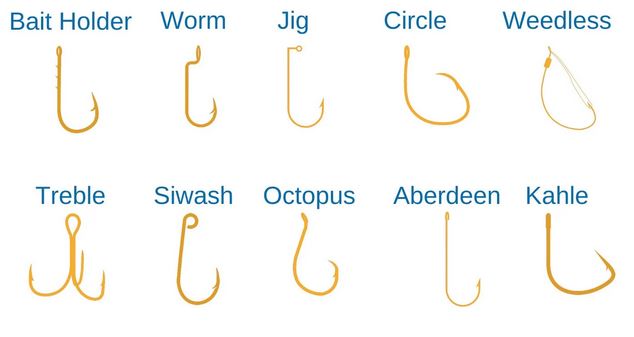
Bait Holder Hook
The most common type of hook used for entry-level fishing is the Bait Holder hook. This hook is perfect for rigging worms, minnows, and other live baits for a variety of styles for fishing. Bait Holder hooks are found on pickerel rigs and worm harness which are very popular and easy to rig for beginner anglers.
Weedless Hooks
These hooks are used in heavily vegetated fishing areas. The wire covers the hook and allows for the sharp point to only be exposed when pushed down or bite by a fish. Weedless hooks are rigged with plastic baits and used mostly for fishing ponds and shorelines for sport fish like Smallmouth Bass and Pike.
Treble Hooks
Treble hooks are found on hard plastic swim and crank baits that are used for targeting a variety of larger fish. These hooks raise the angler’s chance of setting the hook, although it makes for a more difficult removal of the fish once caught. This style of hook is usually removed with pliers and should only be used around more experienced fisherman.
Worm Harness
When casting or trolling on a boat with a live bait, a worm harness is a good option that can cover distance and attract fish. The bright coloured spinners reflect off the sun and create light that fish associated with feeding, while also getting the natural sent of the bait.
Pickerel Rig
This style rig is perfect for casting out and waiting for a bite to reel in. Pickerel rigs are good for controlling depth and target a variety of freshwater fish. The sinker will allow for stability creating a difference in depths for both hooks, leaving one bait suspended inches from the other which is laying on the bottom. These rigs come on a clip which allow for easy hookup of any live bait and hook sizes can be change easily.
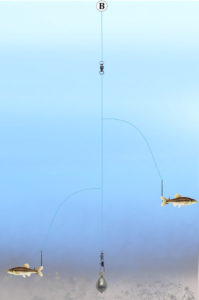
11. Setting up your Fishing Rod
Learn to Fish Online – Parts of a Fishing Rod
How to harness a worm on a hook
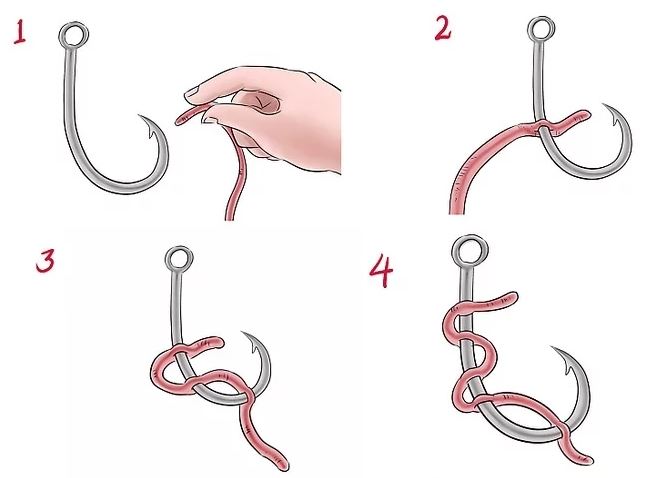
Step 1: Face your hook towards your hand and position the top of the worm to the tip of the hook.
Step 2: Push the worm through the hook 2-3 cm from the tip, leaving room for the worm to be re-hooked.
Step 3: Bring the excess worm around after the first loop through the hook, and continue to re-hook it every 2-3 cm.
Step 4: Repeat this process until the worm is completely harnessed.
Learn to Fish Online: How to rig a fishing rod
Learn to Fish Online: How to cast
Learn to Fish Online: How to tie a Palomar knot
12. What can you Expect to Catch?
The Detroit River is home to over 65 species of fish! The more commonly targeted fish for sport and consumption include Silver Bass, Largemouth Bass, Smallmouth Bass, Rock Bass, Yellow Perch, White Perch, Bluegill, Crappie, Northern Pike, Muskellunge, Walleye, Brown Bullhead, Carp and Channel Catfish.
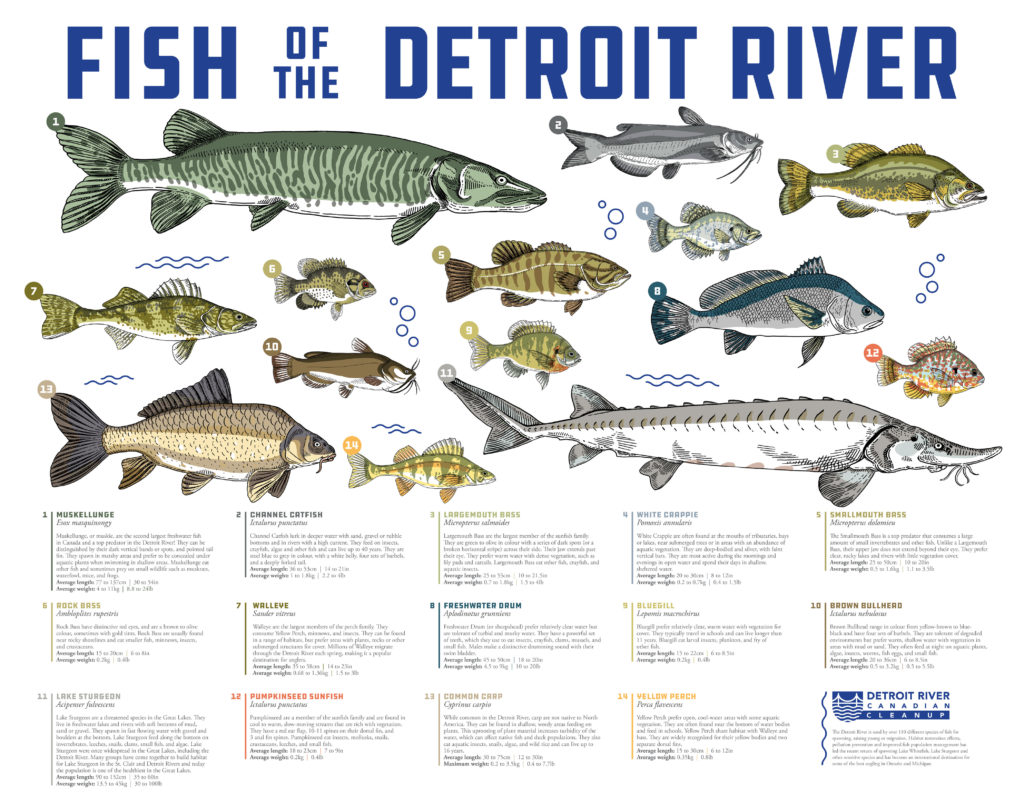
Learn to Fish Online: Smallmouth and Largemouth Bass
13. Handling Detroit River Fish Safely
Many anglers enjoy taking photos of themselves and their catch to share with friends and family and the fishing community. Safe handling of fish ensures that they are not being put under unnecessary stress and causing unintentional damage so they can survive long after they are released into the water. These fish deserve to be handled and released with patience, care and respect.
Learn to Fish Online: Fish anatomy and handling
Catfish
When handling catfish it is important to avoid the spiny bones that stick out from the fish’s fins. By sliding your hand behind the fins, you can hold the fish by the tail and head safely. Unhooking catfish with pliers will also help avoid feeling discomfort from their sharp fin bones. For more detailed information about handling catfish click here.
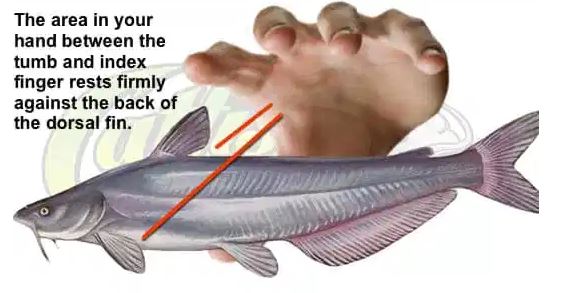
Perch, Bass and Panfish
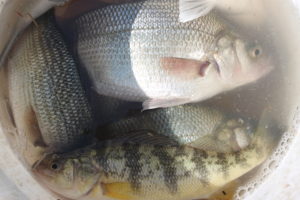
These types of fish do not have teeth that are a danger when handling. To remove your hook, simply hold the fish with your thumb facing downward and press firmly on the handle to work it out of their mouth. Perch and Panfish have spiny rays that can be pulled down by placing your hand near the fish’s head and sliding it down to the midsection to hold them firmly while handling.
If you are having trouble removing your hook, you can use needle nose pliers. Bass species can be more active when out of water so try to have a firm but respectful grip on there lip when handling.
If at anytime you feel it may be taking longer then expect to unhook the fish, it is okay to put them back in the water for a quick moment then try again. This will allow the fish to get a quick breath and lower the chance of accidental death.
Muskellunge, Pike and Walleye
These species are larger in size, are more active when reeling in and handling and have large, sharp teeth. A net should be used to remove them from the water to support the fish, avoid being bit and prevent them from snapping the fishing line. It is important to unhook with long pliers to keep your hands at a safe distance from their mouth. These fish should be held with one hand under their gills and the other should be supporting their midsection. Muskellunge and Pike typically have a coat of slime on their bodies which make them slippery and more challenging to handle. Using a small rag or towel can help when holding them. These fish are also very flexible and can bend all the way from head to tail unlike other fish which must be taken into consideration while handling and measuring their length.
14. Catch and Release
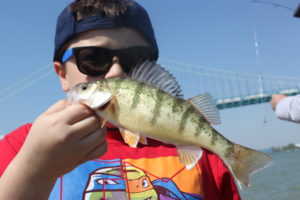
Catch and release is practiced in recreational fishing where the fish, after capture, is unhooked and returned to the water. The use of catch and release by anglers increasing as part of conservation efforts but also because fisheries managers are mandating catch and release practices. By practicing safe handling of fish (mentioned in section above), catch and release techniques can reduce the level of mortality of fish in recreational sport. For more information about catch and release from the Ontario Government, click here.
15. Catching Species at Risk
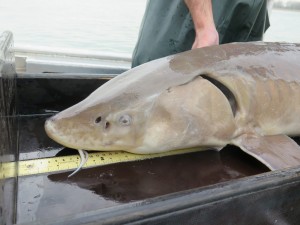
The Detroit River is home to over 65 species of fish. Some of them in the river have current Species at Risk (SAR) designations at both the federal and provincial levels. Threats to fish populations include pollution, siltation or sedimentation, habitat alteration or destruction, invasive species and diseases or viruses.
Protecting and recovering species at risk and their habitat is a key part of conserving Ontario’s biodiversity. DRCC partners have initiated many habitat projects focusing on fish populations in the river channel. Some notable projects include the Lake Sturgeon reef project and habitat restoration work that is ongoing at Peche Island. To see a deatailed story map of these projects and more visit the DRCC Story Map and explore!
While out on the river, if you accidentally catch a SAR, and you are not licensed to do so, please practice safe fish handling and catch and release.
To review Species at Risk in Ontario and their designations, click here.
To review a list of aquatic species listed under the Species at Risk Act and protected by the Fisheries Act, click here.
16. Catching Invasive Species
In Ontario, the Invasive Species Act sets out rules to prevent and control the spread of invasive species. Species regulated under these acts pose a risk to Ontario’s natural environment. Read more about Ontario’s rules to help stop the spread of these species and protect the natural environment.
Federal regulations under the Fisheries Act include rules for Ontario’s invasive fish and aquatic species throughout Canada.
Under the federal rules, in Ontario it’s illegal to:
- import, possess, transport or release bighead carp, black carp, grass carp, silver carp and snakeheads unless they are dead and eviscerated (gutted)
- possess, transport or release round goby, tubenose goby, rudd or ruffe unless they are dead
It’s illegal to possess or use any of these fish as bait, even if they are dead.
It is also illegal to:
- bring zebra or quagga mussels into Canada
- introduce aquatic species to areas where not naturally found
Fishing with live bait
To catch and fish with certain types of live bait already found in Ontario waters, you need:
- the proper fishing licence
- to follow the rules for fishing with live bait, including where you can do it and how much you can catch
It’s illegal to:
- empty your bait bucket in or within 30 metres of a body of water, including on the ice
- bring any crayfish, salamanders, live fish or live leeches into Ontario for use as bait
17. How to Measure your Fish
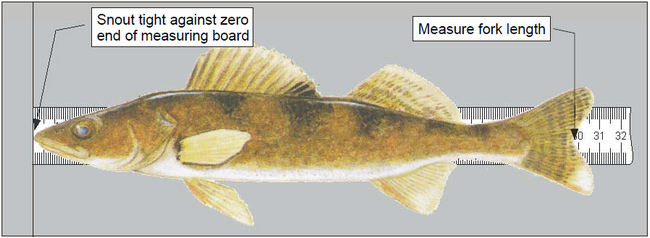
Measuring your fish is a fun component of recreational angling. It also encourages angler compliance with fishery management regulations as well as ensures safe fish consumption. Once your catch is out of the water, take the hook out by handling the fish safely. It helps to have a ruler, measuring tape or other type of measuring device laying flat on the ground. Place the fish on the measuring tape lining the fish mouth or ‘tip’ to the start of the measuring tool. The number you will record is the farthest bit of the tail while the fish is laying flat.
18. Eat Safe Fish from the Detroit River
The Guide to Eating Ontario Fish 2019-2020
Fish can be an important part of a balanced diet. They are a great source of high-quality protein, beneficial omega-3 fats, and other nutrients. At the same time, there is a risk of exposing ourselves and our families to harmful contaminants in fish, such as mercury. Based on their size, type, and location, certain fish may be more suitable to eat than others.
The Guide to Eating Ontario Fish provides easy-to-use information to help choose fish caught from Ontario lakes and rivers to minimize exposure to toxins. Consumption advice in the guide is based on guidelines provided by Health Canada.
How to use the Guide to Eating Ontario Fish 2017-2018
Fish Consumption Advisory Tables for the Detroit River
The advisory tables provide fish consumption advice based on the level of contaminants found in fish according to their location, species and length. Click on the Detroit River locations below for the consumption advisory tables. The advisories represent the maximum number of meals per month recommended for each species/size range indicated.
Lake Erie 5a – upper Detroit River from Lake St. Clair to Fighting Island
Lake Erie 5a – lower Detroit River from Fighting Island to Lake Erie
Reducing the risk from contaminants in fish
Here are three quick tips for eating less contaminated fish:
- Eat smaller fish. Smaller fish tend to be much less contaminated than larger fish of the same species.
- Eat leaner fish from the Great Lakes. In the Great Lakes, species such as Bass, Pike, Walleye, Perch and panfish tend to have much lower contaminants than fatty species like Salmon and Trout.
- Eat panfish or whitefish from inland locations. At inland locations, top-predatory fish such as Pike and Walleye generally have greater contaminants than panfish or whitefish.
19. Cleaning Fish from the Detroit River for Consumption
Toxins such as polychlorinated biphenyls, pesticides and dioxins concentrate to the highest levels in fish with fatty flesh such as Salmon, Trout, Carp and Catfish.
Before cooking, remove the skin, trim off the fatty areas and discard the flesh around the belly area. You can further reduce contaminants by allowing fat to drip away during cooking (e.g., grilling, broiling or baking). If you deep fry fish, do not re-use the oil.
NOTE: Toxins such as mercury and perfluorooctane sulfonic acid, are evenly distributed in fish flesh so there is nothing you can do to reduce or remove them.
How to trim and cook fish to reduce contaminants
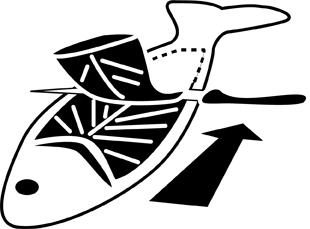
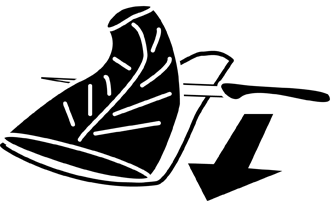
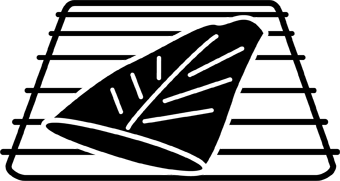
Learn to Fish Online: How to fillet a fish
20. Recipes
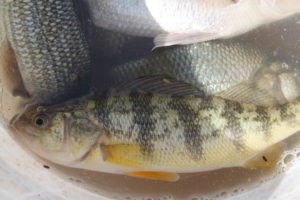
There are many great websites that highlight favourite Great Lakes recipes! Check out some of our favourites below.
Hooked on Fish- Recipes from the Great Lakes State
Recipes – Great Lakes Fisherman
Recipe Box: Great Fish Recipes for Great Lakes Fish
21. TWEPI Fishing Guide

Visit the Tourism Windsor Essex Pelee Island Fishing Guide to explore bait and outfitters, charters, fish found in YQG and fishing hot spots!
22. Where to Buy Fishing Gear in Windsor-Essex
Below is a list of popular retail stores that have fishing gear for purchase in Windsor-Essex, close to the Detroit River.
Strictly Fishing
3399 Sandwich St, Windsor, Ontario
(519) 253-2238
D & D Lures
1576 Howard Avenue, Windsor, Ontario
(519) 256-8073
Ambassador Wholesale Live Bait Ltd.
729 Caron Ave, Windsor Ontario
(519) 253-3694
Lindquist Bros Bait Co Ltd./Canadian Wiggler
1650 Shawnee Road, Tecumseh, ON
(519)-735-4171
info@canadianwiggler.com
www.canadianwiggler.com
Bondy Bait Co.
5145 Dumouchelle, Oldcastle, Ontario
(226) 346-1748
johnbondy@mnsi.net
www.bondybaitcompany.com
Domo’s Custom Tackle
1455 Lisgar Drive, Windsor, Ontario
(519) 996-7901
domjen@sympatico.ca
www.leadheadjigs.com
23. Sportsman’s Clubs in the Detroit River Watershed

Sportsman clubs are a great way to get involved with individuals locally who are active in the conservation and appreciation of natural resources. Along the Detroit River, there are three clubs!
Riverside Sportsman Club
10835 Riverside Drive East, Windsor, Ontario
(519) 735-3031
www.rscwindsor.com
Windsor Sportsmen’s Club
2401 Dougall Avenue, Windsor, Ontario
(519) 966-1600
Ama Sportsmen’s Association
468 Lowes Side Rd, Amherstburg, Ontario
(519) 736-5706
www.amasportsmen.com
